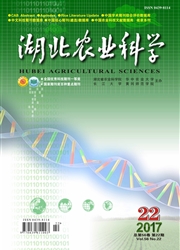

 中文摘要:
中文摘要:
The effects of ammonium (NH4+-N) and nitrate (NO3- - N) were examined on Fe fractions and FeCN (ferricyanide) reductase activity in intact root tips (0-3 cm) of young maize (Zea mays L. cv. Lenz) in solution culture by using short-term experiment under controlled Fe deficiency conditions (containing high HCO3- concentration in pre-culture solution). The results showed that Fe(Ⅱ) concentrations in root tip apoplast of maize were only 20-40 nmol/g FW which accounted for 7%-13% of total Fe. Most of Fe in root tips existed as Fe(Ⅲ) compounds. Imposition of the roots to NH4+ - N or NO3- - N for 60 min led to an increase of Fe(Ⅱ) in root tip apoplast. NH4+ - N led to an increased concentration of Fe(Ⅱ) and exchangeable Fe (Fe(Ⅱ) and Fe (Ⅲ)) in root tips, while NO3- - N increased FeCN reductase activity. The relationship between pH and Fe fractions, FeCN reductase activity was also discussed.
 英文摘要:
英文摘要:
The effects of ammonium (NH 4 + -N) and nitrate (NO 3 ? -N) were examined on Fe fractions and FeCN (ferricyanide) reductase activity in intact root tips (0–3 cm) of young maize (Zea mays L. cv. Lenz) in solution culture by using short-term experiment under controlled Fe deficiency conditions (containing high HCO 3 ? concentration in preculture solution). The results showed that Fe(II) concentrations in root tip apoplast of maize were only 20–40 nmol/g FW which accounted for 7%–13% of total Fe. Most of Fe in root tips existed as Fe(III) compounds. Imposition of the roots to NH 4 ±N or NO 3 ?N for 60 min led to an increase of Fe(II) in root tip apoplast. NH 4 ±N led to an increased concentration of Fe(II) and exchangeable Fe (Fe(II) and Fe (III)) in root tips, while NO 3 ? -N increased FeCN reductase activity. The relationship between pH and Fe fractions, FeCN reductase activity was also discussed.
 同期刊论文项目
同期刊论文项目
 同项目期刊论文
同项目期刊论文
 期刊信息
期刊信息
